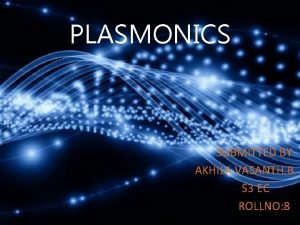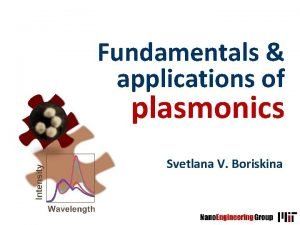Plasmonics of Normal and Inverted CoreShell Nanostructures Sudip

- Slides: 1

Plasmonics of Normal and Inverted Core-Shell Nanostructures Sudip Kumar Pal 1, Sujit Kumar Ghosh 1 1. Department of Chemistry, Assam University, Silchar-788011, India Introduction: Our work focuses on the synthesis of normal and inverted gold-silver core-shell nanostructures following the method of Pal group. The normal and inverted core-shell nanostructures so formed have been characterized by transmission electron microscopic and UV-visible spectroscopic techniques. We have simulated the electric field generated using finite difference time domain (FDTD) and discrete dipole approximation (DDA) method and validated the experimental results with theoretical calculations. a = 10 µL , 10 m. M Ag. NO 3 solution b = 20 µL, 10 m. M Ag. NO 3 solution c = 30 µL, 10 m. M Ag. NO 3 solution d = 40 µL, 10 m. M Ag. NO 3 solution a = 10 µL, 10 m. M HAu. Cl 4 solution b = 20 µL, 10 m. M HAu. Cl 4 solution c = 30 µL , 10 m. M HAu. Cl 4 solution d = 40 µL, 10 m. M HAu. Cl 4 solution a a b c d d Figure 1. Synthesis of normal and inverted core-shell nanostructures Computational Methods: Electromagnetic field generated on the surface due to the light-matter interaction has been modeled with the RF module, setting corresponding incident wavelength as recorded from the absorption spectra. Results: As the amount of silver nitrate solution added increases, the peak of silver become more prominent with increasing thickness for Aucore-Agshell, but reverse phenomenon is observed for Agcore-Aushell nanostructures. Figure 3. Absorption spectra of different shell thickness of Aucore-Agshell Figure 4. Absorption spectra of different thickness of Aucore-Agshell A two dimensional layered motif has been considered to model the plane wave interaction with the hybrid layered spheroid morphology. The electromagnetic coupling is shown through the surface plot as given in Figure 5. FEM Simulation of Normal and Inverted Core Shell of Different Thickness: Finite difference time domain (FDTD) calculations of the nanostructures signify their respective monopolar and multipolar nature. Figure 6 shows the results obtained for a plane wave interacting with a fixed size core with different shell thickness. Figure 6. FDTD simulation of core-shell of different shell thickness DDA Simulation of Normal and Inverted Core. Shell of Different Thickness: The extinction profile shows that as the thickness increases, the peak shifted to the higher wavelength for both normal and inverted core-shell nanostructures. Figure 4. Absorption spectra of different shell thickness of Agcore-Aushell Transmission Electron Micrographs of Normal & Inverted Core-Shell Nanostructures: Core-shell structure shows a more dense interior core of gold surrounded by a thinner shell and inverted core-shell structure shows a less dense interior core of silver surrounded by a thicker shell. Figure 5. FEM of Aucore-Agshell Figure 7. DDA simulation of different shell thickness of Aucore-Agshell Figure 8. DDA simulation of different shell thickness of Agcore-Aushell Conclusions: We have successfully introduced FEM and DDA simulations to account for different thickness of normal and inverted core-shell structures. References: 1. Ghosh, S. K. ; Pal, T. Chem. Rev. 2007, 107, 4797.

